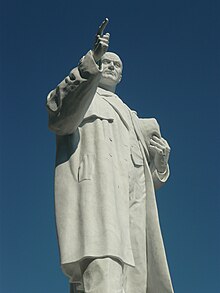Antifascist Council for the People's Liberation of Macedonia
The Anti-Fascist Council of the People's Liberation of Macedonia ( Macedonian Антифишистичко Собрание на Народното Ослободување на Македонија , contemporary Антифашиско собрание на народното ослободуене на Македонија, shortly ASNOM ) was 1944/1945, the highest state body in the Macedonian part of the state of the communist , Yugoslav partisans created new federal Yugoslavia and the regional counterpart to the AVNOJ . At the end of 1944, the first government of the socialist republic of Macedonia emerged from the ASNOM.
In Macedonia , broader resistance against the occupying powers came relatively late. Neither the Serbian Chetniks nor the communists had a mass base in southern Yugoslavia. The communists were also weakened by political disputes between the Bulgarian and Yugoslav CPs . Both parties claimed the leadership role in the anti-fascist struggle in Bulgarian- occupied Macedonia. In the course of 1943, the Tito partisans were finally able to prevail and the Macedonian communists were subordinate to their leadership. Now larger partisan units were also formed in Macedonia, which inflicted noticeable losses on the German , Bulgarian and Albanian occupying forces from the beginning of 1944.
After several months of preparation was constituted on August 2, 1944 today Serbia belonging Pčinjski Monastery St. Prohor north of Kumanovo of the Anti-Fascist Council of the People's Liberation of Macedonia. The day of the Ilinden uprising , which is symbolic for Macedonia, was chosen as the foundation day . The council had 17 members and was the military and political leading body of the liberation movement in the territory of the later republic until the Republic of Macedonia was founded. Chairman was Metodija Andonov Cento selected. At the founding meeting, the " Macedonian vernacular was declared the official language " through a resolution . The aim was to develop an independent national identity .
With regard to military and political goals, there were clear differences between the Macedonian ASNOM and Tito's central leadership. A strong group of Macedonian partisans around Andonov Čento would have preferred to march into the Greek part of Macedonia in late 1944 / early 1945 in order to conquer this area, including Thessaloniki, for Yugoslavia and the Republic of Macedonia. However, the AVNOJ prevailed and the Macedonian units advanced north in autumn 1944 to take part in the fight against the troops of the German Reich and the Ustasha state .
See also
literature
- Evgeni Dimitrov (Ed.): ASNOM. Pedeset godini Makedonska Država, 1944–1994. Skopje 1995.
Individual evidence
- ↑ Wolf Oschlies : Textbook of the Macedonian language. In 50 lessons. Sagner, Munich 2007, ISBN 978-3-87690-983-7 , p. 9: “[…] the decision of the ASNOM (Antifascist Council for the Liberation of Macedonia), which was passed on August 2, 1944 in the southern Serbian monastery of Sv. Prohor Pćinjski proclaimed the Republic of Macedonia (within the Yugoslav Federation) and in this the "Macedonian vernacular as the official language". "
- ^ The Making of the Macedonian Alphabet

